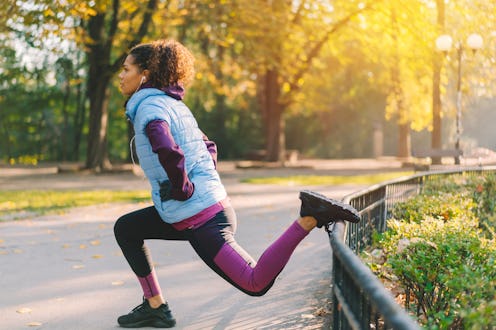Fitness
How To Nail The Bulgarian Split Squat, According To Trainers
It’s difficult but worth it.

You know how to drop into a classic squat, but if you avoid Bulgarian split squats because they look too complicated, you might want to reconsider. While the lower body exercise is definitely challenging, it’s totally doable once you know how to properly set it up. And its many benefits are very much worth the effort.
A Bulgarian split squat is a partially elevated move, says AFAA-certified fitness instructor Alayna Curry. The goal is to balance on one leg as you lower yourself into a squat. This allows you to focus on one side of your body at a time versus working both sides at once. “Since it’s an isolated movement, it’s really effective at building up strength in each leg individually to help improve muscle imbalances, as many of us have,” Curry tells Bustle.
It also targets the muscles of your lower body in a more intense way than your everyday squats. “While squats in general are a great exercise, the Bulgarian split squat puts the pressure on one leg, making it a more focused strength exercise that builds stronger quads, hamstrings, and glutes,” John Gardner, a NASM-certified personal trainer and CEO and co-founder behind Kickoff, tells Bustle.
The move engages your core, too. “Because you focus on a single leg, it is essential to engage the core to maintain balance,” Gardner adds. “This helps work the core even more to build stronger core muscles.” And, of course, you’re working on your balancing skills as you hold yourself up. It’s a difficult exercise, but it’s worth it. Read on for how to do a Bulgarian split squat properly so you can get the most out of the move.
How To Do A Bulgarian Split Squat
Here, Curry shares how to do a Bulgarian split squat in perfect form. You’ll need an elevated surface, like a gym bench, plyo box, or a household item like a chair or couch, though you can also do them outside using a low wall, step, or bench.
- Stand about 2 feet in front of the elevated surface.
- Lift your left leg and reach back to rest the top of your foot on the surface. Alternatively, you could flex your foot and rest the ball of your foot (whichever is more comfortable for you).
- Bend your right knee to get into a lunge position.
- Place your hands on your hips or hold dumbbells at your sides.
- Slowly bend your legs to lower into a squat, making sure your right knee remains directly over your right toes.
- Engage your glutes to rise back up.
- Do this 10 times, then switch sides.
Aim for a total of 3 rounds.
Common Mistakes To Avoid
As with any lunge or squat, one of the most common mistakes is letting your front knee extend past your toes. While this over-extension could potentially lead to added stress or injury on your joint, Curry says this is more about maintaining proper form so you get the most bang for your buck.
“Another thing to remember is that your legs should be on train tracks, not a tight rope — meaning that you want to be about hip-distance apart, not one leg directly in front of the other,” Curry says. If you feel off-balance, she recommends adjusting your gaze to be about six feet in front of you or straight ahead, versus looking straight down at the ground.
As you press back up from the lowest point of your squat, be sure to press through the heel of your planted foot, Gardner says. “A common mistake is to press against the toes and ball of your foot. This could also happen when you’re too close to the bench/step and need to tiptoe to move forward. Instead, ensure you're positioned correctly to start off with.”
How To Modify A Bulgarian Split Squat
To make this exercise less difficult, rest your back foot on a lower surface, like your couch. Do fewer reps to start until you build up strength. And if you feel wobbly, trainers recommend performing the move next to a wall so you can hang onto it for support.
If you want to take the move up a notch, first of all, more power to you. Second, simply look for a higher surface to rest your foot on. Curry says the larger the deficit and deeper the squat, the more you’ll work your glutes.
Once you’ve gotten the hang of that, Gardner says you may also want to hold dumbbells or kettlebells in each hand to increase resistance and make the move even more challenging. Just prepare to feel the burn in your legs.
Studies referenced:
Andersen, V. (2014). Muscle activation and strength in squat and Bulgarian squat on stable and unstable surface. Int J Sports Med. 2014 Dec;35(14):1196-202. doi: 10.1055/s-0034-1382016. Epub 2014 Sep 25. PMID: 25254898.
Experts:
Alayna Curry, AFAA-certified fitness instructor
John Gardner, NASM-certified personal trainer
This article was originally published on